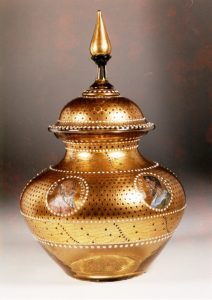Deckeldose des Historismus – Deutsch/German

Die in Form und Vergoldung orientalisch anmutende Deckeldose stammt von Antonio Salviati. Die Dose steht für die Erneuerung der venezianischen Glaskunst nach dem Rückgang im 18. Jahrhundert.
Antonio Salviati hatte 1866 die Società Salviati e Companie in Venedig gegründet. Wie später in den 1920er Jahren Paolo Venini richtete Salviati seinen Blick auf die Perfektion handwerklichen Könnens ebenso wie auf das Künstlerische. Mit dem Kopieren alter Modelle verhalf er der Venezianischen Glaskunst um die Mitte des 19. Jahrhunderts zu neuem Weltruhm. Dabei verzichtete er auf jene dekorativen Schnörkel, die das Bild Venedigs bis heute bestimmen.
Die anderen über 20 Dosen in dieser Vitrine stehen beispielhaft für die Vielzahl an Techniken, Formen, Farben und Stile, die die Glaskunst aufgrund der enormen glastechnologischen Errungenschaften um 1900 vorweisen konnte. Die Dosen sind weiß, blau, grün, schwarz oder gold. Sie wurden gepresst, geblasen, geschliffen, graviert oder bemalt. Sie sind rund, eckig, in Form eines Fisches, Hundes oder Vogels, einer Weintraube oder einer Krone.
Lidded Container in the Style of Historicism – English

Antonio Salviati created this container with lid, which is oriental in style in both the shape and the gilding. It represents the renewal of Venetian glass art after the 18th-century decline. Antonio Salviati founded die Società Salviati e Companie in Venice in 1866, and like Paolo Venini during the 1920s, his focus was on both the perfection of the craft and its artistic appeal. By copying old models he helped Venetian glass art to achieve new world fame in the mid-19th century, but forewent any decorative embellishments, which still define our view of Venice today.
The other containers in this showcase, there are over 20 of them, stand as an example of the variety of techniques, shapes, colours and styles glass art produced as a result of the enormous technological achievements in the field in around 1900. The containers are white, blue, green, black, or gold and they were pressed, blown, cut, engraved, or painted. They are round, square, shaped like fish, dogs, or birds, a vine, or a crown.